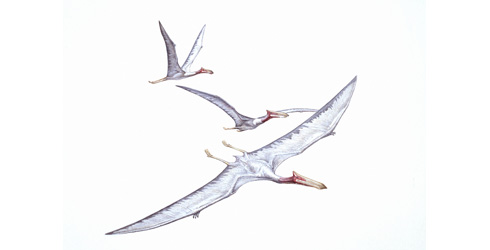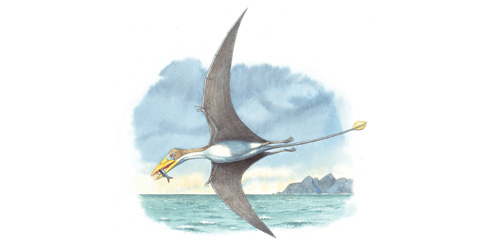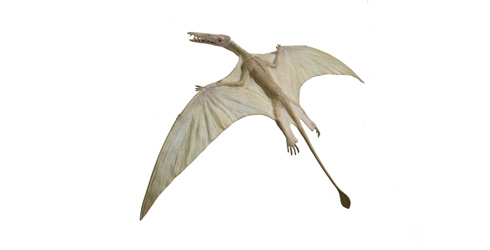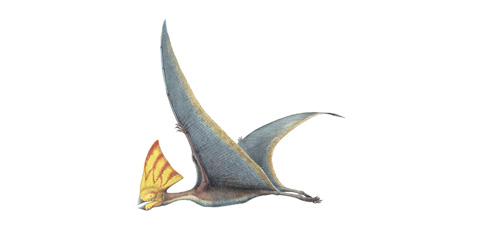- Home
- > Nature online
- > Life
- > Dinosaurs and other extinct creatures
- > Non-dinosaur reptiles
- > Flying reptiles
Primary navigation
- Life
- Mammals
- Birds
- Reptiles, amphibians and fishes
- Insects and spiders
- Other invertebrates
- Dinosaurs and other extinct creatures
- Dino directory
- The most complete Stegosaurus in the world
- Prehistoric world in pictures
- News
- Archaeopteryx - snapshot of evolution in action
- Mass extinctions
- Non-dinosaur reptiles
- Ida - the clue to primate evolution?
- Baryonyx (video)
- Augmented reality Coelophysis
- Scelidosaurus (video)
- World's smallest mini mammoth (video)
- Dino-birds
- Big teeth for a tiny dinosaur
- T.rex: the killer question quiz
- Virtual specimens
- Ostrich dinosaurs
- The search for DNA in amber
- Plants and fungi
- Human evolution
Flying reptiles
The flying reptiles are called pterosaurs. They ruled the skies from the late Triassic Period to the end of the Cretaceous Period (228 to 66 million years ago). They were the first vertebrates to evolve flight. Contrary to popular belief, pterosaurs are not dinosaurs. Find out more about some of these reptiles below.

Name: Quetzalcoatlus
Age(s): 70-66 million years ago
Period: Late Cretaceous (Maastrichtian)
Size: Wingspan 10-12 metres
Location(s) found: USA (Texas)
Notes: Quetzalcoatlus was the largest known pterosaur and had the largest wingspan of any known flying animal. It is named after Quetzalcoatl, the feathered serpent of Aztec myth. It was toothless with a long neck and a short tail and probably fed on fish or carrion. A small-scale model has been made that was able to fly, with a little assistance.

Name: Anhanguera
Age: 110 million years ago
Period: Early Cretaceous (Albian)
Size: Wingspan of 4-5 metres
Location(s) found: Brazil, Australia (Queensland), UK (England)
Notes: Anhanguera was a fish-eating pterodactyloid. It had a long snout with a low crest. Several specimens are known, including some preserved in three dimensions in calcareous nodules. These specimens allow scientists to make reconstructions of the brain and, from the orientation of the semi-circular canals in the ears, they show that it held its head tilted downwards. Anhanguera means 'malignant spirit' in the language of the Tupi and Guarani Indians.

Name: Campylognathoides
Age(s): 200-186 million years ago
Period: Early Jurassic (Pliensbachian-Sinemurian)
Size: Wingspan of 1.75 metres
Notes: Campylognathoides was a rhamphorhynchoid pterosaur, a group characterised by having a long bony tail. It was named by Strand in 1928 and its name means 'curved jaw'. It had a relatively short skull and large eyes.

Name: Dimorphodon
Age(s): 195-190 million years ago
Period: Early Jurassic (Norian-Hettangian)
Size: Wingspan of 1.4 metres
Location found(s): UK (Dorset), Mexico (Tamaulipas)
Notes: Dimorphodon had a very large head. It probably ate insects and other small animals. It was named in 1859 by Sir Richard Owen and its name means ‘two-form teeth’. A well-preserved specimen was found by Mary Anning (who also found many specimens of ichthyosaurs) at Lyme Regis in Dorset. Two species are known, Dimorphodon macronyx and Dimorphodon weintraubi.

Name: Dorygnathus
Age(s): 200-188 million years ago
Period: Early Jurassic (Pliensbachian-Sinemurian)
Size: Wingspan of 1 metre
Notes: Dorygnathus means 'spear jaw'. Its teeth were long, forward-pointing and needle-like, and Dorygnathus most probably fed on fish. Its wings were relatively short compared with those of other pterosaurs.

Name: Rhamphorhynchus
Age(s): 172-144 million years ago
Period: Mid to Late Jurassic (Aalenian-Tithonian)
Size: Wingspan of 0.4-1.75 metres
Location(s) found: Germany (Solnhofen, Wurttemberg), UK, Portugal, Tanzania
Notes: Rhamphorhynchus had thin, forward-pointing teeth and ate fish. Its name means ‘beak jaw’. It is known from several well-preserved specimens, and a reconstruction of the brain shows that it was an agile flier. Some specimens have skin impressions that show details of the wing membrane, the presence of a diamond-shaped fin on the end of the long tail, and even a throat pouch.

Name: Tapejara
Age(s): 121-112 million years ago
Period: Early Cretaceous (Aptian-Albian)
Size: Wingspan of up to 5 metres
Location found(s): Brazil
Notes: Tapejara had a large head crest, which was up to a metre in height in some specimens. It may have been used by males for display. The head crest had a keratinous covering, which, in some specimens, enhanced the bony crest with prongs. Its name means 'old being' in the language of the Tupi Indians.

Name: Pteranodon
Age(s): 86-73 million years ago
Period: Late Cretaceous (Santonian-Campanian)
Size: Wingspan of 7 metres (Pteranodon longiceps), 9m (Pteranodon sternbergi )
Location(s) found: USA (Kansas, Nebraska, Wyoming, Alabama, South Dakota)
Notes: Pteranodon is famous for its head crest, which varied in shape. P. longiceps had a long narrow crest, wheras P. sternbergi had a wider crest. Pteranodon was toothless and fed on fish, and fish remains have been found in the stomach region of some fossils. It belongs to the group Pterodactyloidea, characterised by having short tails.
Toolbox
- Contact and enquiries
- Accessibility
- Site map
- Website terms of use
- © The Trustees of the Natural History Museum, London
- Information about cookies
- Mobile